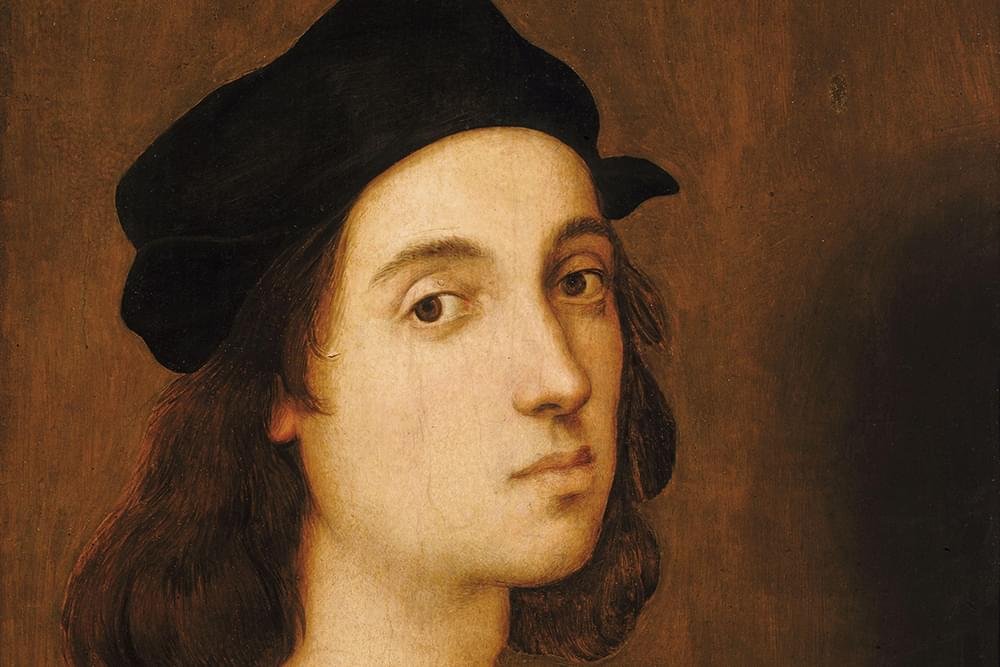
It is impossible to think of Italy without conjuring images of arguably her greatest artist; Raffaelo Sanzio de Urbino. Or Raphael as he is known. Described by the National Gallery as the youngest of Italy’s three greats. They have this to say about him. “What Leonardo achieved by sheer intellect and Michelangelo through passionate intuition, Raphael acquired by persistent study and assimilation.”
Born in 1483, Raphael only lived to the age of 37, yet he was more prolific than Da Vinci and more versatile than Michaelangelo, running a workshop that was the largest of his time.He is best known for his madonnas and his designs in the Vatican palace.
His father Giovanni Santi was a court painter in Urbino and little Raffaelo grew up surrounded by art. Urbino was a cultural centre at the time. Giovanni schooled his son in basic art techniques and humanistic philosophy. A child prodigy, Raphael’s early training allowed him to accomplish much in his short life. Raphael was the only child of his parents to survive infancy. His mother died when he was none and his father remarried only a year later. However, tragedy struck again, at the age of only 11, Raphael was left truly orphaned with the death of his father. Raphael had to take on the burden of his father’s workshop. Not only did he manage, he excelled, and the workshop thrived, becoming even more successful than under his father. As a young teenager he was commissioned to paint the Church of San Nicola of the nearby town of Castello.
In 1500, at the age of 17, he was invited by Perugino to be his apprentice in Florence. For the four years that Raphael trained under him, he became a master in his own right. He was very influenced by Perugino in his early works. In 1504 at the age of 21, Raphael left to seek his own fortune and settled in Florence, learning from the works of Da Vinci and Massacio and Michaelangelo. Studying their style led to a period of experimentation, eventually developing his own style as he matured.
In 1508, he was summoned to the court of Pope Julius II to help redecorate the papal apartments, promoting him to be an independent master. From then on, till his death on the 6th April 1520, Raphael worked in Rome, becoming a master of portraits and specialising in madonnas.
Much of his later work was conducted by his workshop, meaning the quality was diminished, but the proliferation meant he became well known. He was the most productive artist of his time. After his death, Michaelangelo was regarded as the greatest painter due to his many, many works that were spread all across Italy. However, in the course of time, Raphael’s skill and subtlety, his skin tones and gentle humanitarianism, came to be recognised as the greatest art that the renaissance produced.
Raphael’s paintings seek to emphasise man’s role as supreme and explored the nature of man’s mastery through the intense beauty of his works. The signature techniques that characterised the Renaissance period, such as sfumato, anatomic precision, perspective, expression and emotion were not only mastered and exemplified in his works, but Raphael established his own style. His clarity and rich colour as well as complexion and grandeur completed the rise of renaissance art to its peak.
Raphael’s greatest rival was his contemporary Michaelangelo. However, Raphael was a people person which gave him an edge over Michaelangelo. A hit with the ladies and a smooth talker of amicable personality, Raphael’s gentle nature won him universal approval and opened doors for him that his rival couldn’t achieve with his paintbrush alone.
Raphael’s greatest works were the painting of the marriage of the madonna and the four frescoes in the Vatican palace. In the Stanza della Segnatura, one of the four rooms Raphael decorated in the palace, the four walls bear four great paintings. Each one depicts separately: philosophy, poetry, theology, and law.
As Raphael’s workshop grew, and he had his apprentices handle commissions, Raphael began to branch out into architecture, becoming the Pope’s chief architect in 1514. He designed churches and palaces until a mysterious illness struck him and he died in the middle of one of his great works - the transfiguration. They placed the unfinished work on his coffin as he was buried in the Parthenon in Rome, Italy.
However, Raphael’s influence continued after his death as his Mannerism style led to the emergence of the baroque period. Best known for the balance and harmony of his compositions, Raphael is widely regarded as on of the greatest masters who ever loved, being the third and final pillar of the Renaissance trinity.

More Details